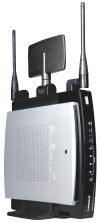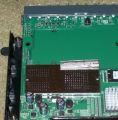Linksys WRT350N v1
Linksys WRT350N v1
Manuf (OEM/ODM): CyberTAN
FCC approval date: 29 September 2006
Country of manuf.: China
S/N prefix: CNQ0
Type: wireless router
FCC ID: Q87-WRT350N
IC ID: 3839A-WRT350N
Power: 12 VDC, 1.25 A
Connector type: barrel
CPU1: Broadcom BCM4705 (300 MHz)
FLA1: 8 MiB8,388,608 B <br />65,536 Kib <br />8,192 KiB <br />64 Mib <br />0.00781 GiB <br /> (Intel JS28F640J3D-75)
RAM1: 32 MiB33,554,432 B <br />262,144 Kib <br />32,768 KiB <br />256 Mib <br />0.0313 GiB <br /> (Nanya NT5DS8M16FS-5T × 2)
Expansion IFs: PCMCIA (32-bit), USB 2.0
PCMCIA slots: 1
USB ports: 1
Serial: yes, 5-pad header, (115200,8,N,1)
WI1 module: CyberTAN WM802-B
WI1 module IF: PCMCIA (32-bit)
WI1 chip1: Broadcom BCM4321
WI1 chip2: Broadcom BCM2055
WI1 802dot11 protocols: bgn
WI1 MIMO config: 2x2:2
WI1 antenna connector: Fixed Non-Removable
ETH chip1: Broadcom BCM4705
Switch: Broadcom BCM5397
LAN speed: 1GbE
LAN ports: 4
WAN speed: 1GbE
WAN ports: 1
bgn
Stock bootloader: CFE 1.0.37-1.08 BCM947XX
Stock FW OS: Linux 2.4.20
Default IP address: 192.168.1.1
the IP 192.168.1.1 is used by 1295 additional devices
of which 153 are Linksys devices
Default login user: blank
Default login password: admin
blank:admin credentials used by 289 additional devices
of which 142 are Linksys devices
802dot11 OUI: 00:1A:70 (9 E, 15 W), 00:1C:10 (9 E, 16 W), 00:1D:7E (10 E, 14 W)
Ethernet OUI: 00:1A:70 (9 E, 15 W), 00:1C:10 (9 E, 16 W), 00:1D:7E (10 E, 14 W)
| FCC ID | |
|---|---|
| CyberTAN WM802-B | QDS-BRCM1023 Q87-WRT350N |
| CPU1 brand | WI1 chip1 brand | WI1 chip2 brand | |
|---|---|---|---|
| Linksys WRT350N v1 | Broadcom | Broadcom | Broadcom |
| Linksys WRT350N v2 | Marvell | Atheros | Atheros |
For a list of all currently documented Broadcom chipsets with specifications, see Broadcom.
Wireless-N Gigabit Router with Storage Link
Links of Interest
- On the OpenWrt wiki
- On the DD-WRT wiki
- Listed on the 'Linksys routers' page on Wikipedia
- Linksys WRT350N Review on SNB
- DD-WRT Support for Linksys WRT350N Ver.2?
Flashing
| NOTE: During configuration or flashing a device, the only things that should be hooked to the device is the computer and power. |
Flashing DD-WRT
| WARNING: Do not flash micro this unit! |
| WARNING: Requires K2.4 for DD-WRT, Do not flash anything else! |
First, before you do anything else, check which version of the WRT350N you have.
- If you have V1, you're in business. If you have V2, you're outta luck.
Flashing a virgin WRT350N with the default Linksys firmware will require a special "trailed" mini-build to be flashed first.
- You should use a build from the BS Broadcom folder 12874 for the initial flash.
- The name of this file specifically is "dd-wrt.v24_mini_wrt350n.bin".
- You may proceed to flash it with a generic build next, such as Mega.bin.
Remember to do the 30/30/30 Hard Reset after every successful flash.
- It is absolutely essential.
The proper process for flashing is:
- Read Note 1 of the peacock announcement http://www.dd-wrt.com/phpBB2/viewtopic.php?t=51486
- Read Note 3 of the peacock announcement
- Download dd-wrt.v24_mini_wrt350n.bin
- Do a Hard reset or 30/30/30 on your router. You will not get a password renewal page as you have stock linksys firmware on the router still.
- Plug a cable into the lan port of the router and your computer, and disable any wireless to the computer. Disable all firewalls and virus protection. (Setting your computer to a static IP should not be required)
- Set your browser to 192.168.1.1. This will open up the linksys webgui
- Enter the username admin and password admin
- Go to the administration tab. Click on firmware upgrade.
- BROWSE to the dd-wrt.v24_mini_wrt350n.bin file you downloaded.
- Click on the upgrade button and WAIT for the upgrade successful message. Wait at LEAST 5 minutes
- Power cycle your router. (very important) WAIT until you can relogin at 192.168.1.1
- Do another PROPER Hard reset or 30/30/30 on your router (very important) WAIT until you can login at 192.168.1.1
- Click on any tab. Reset your username/password by TYPING in a new username/password
- Configure your router
You can now upgrade to any generic dd-wrt build except Micro. Be sure to always do a hard reset prior to flashing another build, do a power cycle followed by another hard reset after flashing, and NEVER re-use a configuration file from a previous build or another router. Reconfigure from scratch.
Flashing OpenWrt
Flashing Gargoyle
From DD-WRT
gargoyle_1.3.13-wrt350n_v1-squashfs.bin
Grab that image from the download section
Linksys WRT350N
Chipset Broadcom 4785
RAM 32 MB FLASH 8 MB
Broadcom chipsets are fairly easy to back-forth between
Gargoyle and DD-WRT
Best recommendation for steps:
- download a backup current DD-WRT build you are using
- backup your current DD-WRT config
- reset dd-wrt to defaults
- from dd-wrt GUI - flash the gargoyle.bin image
- once you start the flash - wait about 5 minutes
- try to login to 192.168.1.1 - defaull password = password
If you want to go back to dd-wrt
- backup your current Gargoyle config
- reset Gargoyle to defaults
- flash the dd-wrt .bin file that you originally saved above
- once again - wait about 5 minutes for flash
- reload your backup config file for dd-wrt
Upgrading
Updating DD-WRT
If dd-wrt is already on the router follow these instructions. If stock firmware is on the router follow the flashing instructions.
- Check for recommended builds here first.
- Set your computer to a static IP of 192.168.1.7. (or to whatever subnet the router is on) Disable all firewalls and security. Disable wireless on your computer and only have the router connected to the flashing computer by the ethernet cable between the two.
- Hard reset or 30/30/30 (If the router supports it, if not, reset to defults in the GUI) prior to flashing. Wait. Check for password page on re-login and change password.
- Flash firmware. You can use the webgui except if you have a belkin router. (For belkin use tftp.exe to flash)
- Wait...at least three minutes. Lights should return to normal. See important2, below. Failing to wait is how most people brick their routers.
- Do a power cycle of the router. (Unplug the cord, count to 30 and plug it back in.)
- Wait for the lights to return to normal usually about 2 minutes.
- Hard reset or 30/30/30 again (If the router supports it, if not, reset to defults in the GUI). Wait. Check for the password page and re-login to change the password. Then you can reconfigure your settings manually.
- Once configured set your computer back to autoIP and autoDNS.
Important1: This Hard reset or 30/30/30 works fine for Asus router, but you do have to power cycle after the reset.
Important2: After you flash the firmware, and before you do the hard reset, the router will be building some nvram settings. YOU MUST WAIT FOR THIS TO FINISH PRIOR TO DOING ANYTHING WITH THE ROUTER INCLUDING A HARD RESET. Usually, you can tell when this process is completed by the WAN light coming on, but it does take several minutes. Go have a beer. There are starting to be more and more people who BRICK their routers by not waiting until the nvram is rebuilt, PRIOR to doing a hard reset. YOU NEED TO WAIT!
JTAG-Serial Info
JTAG
JTAG Pinouts
nTRST 1o o2 GND TDI 3o o4 GND TDO 5o o6 GND TMS 7o o8 GND TCK 9o o10 GND nSRST 11o o12 N/C
Serial
Serial Pinouts
GND 5 o N/C 4 o TX 3 o ? RX 2 o ? VCC 1 o -------- ? 1 o ? ? 2 o ?
Hyper terminal Setup in Windows XP
In Windows XP, Click Start Button - All Programs - Accessories -
Communication - HyperTerminal
Enter a name for the connection, Click ok
Choose com port you adapter is plugged into, Click ok
Set:
Bits per second = 115200
Data Bits = 8
Parity = none
Stop bits = 1
Flow control = none
Click ok
Click File - Save As, and select a place to save it to so you
don't have to enter the settings again.
Putty Setup in Windows XP
After installing putty, run it Serial line = The COM port your using for serial (ie. COM3) Speed = 115200 Click on Serial under Connection Serial line to connect to = same as above (Serial line) Speed (baud) = 115200 Data bits = 8 Stop bits = 1 Parity = none Flow control = none Click Session Enter a name for your connection under saved sessions Click Save Click Open
DD-WRT Serial Recovery
Modified redhawk0 instructions
- Print out these instructions for Off-Line use
- Connect PC to router with a network cable
- Configure PC with a static IP of 192.168.1.10
- Connect Serial cable
- Start one of the programs from above
- Get TFTP ready with file selected
- Use dd-wrt.v24 mini wrt350n.bin
- Connect power to the router
- start a rapid fire Cntl-C as you plug the router to power
- type "nvram erase" w/o quotes, hit enter
- type "flash -noheader : flash1.trx" w/o quotes, this starts the tftp daemon, hit enter
- but have TFTP ready
- Click go or start on TFTP
- give it 5 minutes after it finishes
- then power cycle....Hard reset or 30/30/30...then config
- when it stops spitting out txt....hit the enter key...you should get a login prompt...at that point, power cycle it, hard reset...then config
- you'll see it boot up
USB Info
DD-WRT USB
- The USB port is where you can connect an external USB hard drive or flash drive.
- Which can do a multitude of things. You can use in as a NAS, storage for a FTP
- server, use Optware to run external programs like torrent software, samba for
- sharing files to network, share a USB printer with network...
- The list of possibilities is long, it just takes a little research.
- ProFTPd is included in most the newer builds of dd-wrt.
- Check the features chart to be sure.
vlan Info
DD-WRT vlan Info
I can confirm the WRT350N v1.0 does support port-based vlan's via nvram only, the gui doesn't work. "proc/switch" is not present.
Defaults
root@DD-WRT:~# nvram show | grep vlan.ports vlan2ports=0 8 vlan1ports=1 2 3 4 8* size: 19676 bytes (13092 left) root@DD-WRT:~# nvram show | grep port.vlans port5vlans=1 2 16 port4vlans=1 port3vlans=1 port2vlans=1 port1vlans=1 port0vlans=2 size: 19676 bytes (13092 left) root@DD-WRT:~# nvram show | grep vlan.hwname vlan2hwname=et0 vlan1hwname=et0 size: 19676 bytes (13092 left) root@DD-WRT:~#
Commands
root@DD-WRT:~# nvram set vlan2ports="0 4 8" root@DD-WRT:~# nvram set vlan1ports="1 2 3 8*" root@DD-WRT:~# nvram commit root@DD-WRT:~# reboot
nvram
root@DD-WRT:~# nvram show | grep vlan.ports vlan2ports=0 4 8 vlan1ports=1 2 3 8* size: 19895 bytes (12873 left) root@DD-WRT:~# nvram show | grep port.vlans port5vlans=1 2 16 port4vlans=1 port3vlans=1 port2vlans=1 port1vlans=1 port0vlans=2 size: 19895 bytes (12873 left) root@DD-WRT:~# nvram show | grep vlan.hwname vlan2hwname=et0 vlan1hwname=et0 size: 19895 bytes (12873 left) root@DD-WRT:~#
GUI
Reset to default before test, GUI settings do not work
root@DD-WRT:~# nvram show | grep vlan.ports vlan2ports=0 8 vlan1ports=1 2 3 4 8* size: 19594 bytes (13174 left) root@DD-WRT:~# nvram show | grep port.vlans port5vlans=1 2 16 port4vlans=2 18 19 port3vlans=1 18 19 port2vlans=1 18 19 port1vlans=1 18 19 port0vlans=2 18 19 size: 19594 bytes (13174 left) root@DD-WRT:~# nvram show | grep vlan.hwname vlan2hwname=et0 vlan1hwname=et0 size: 19594 bytes (13174 left) root@DD-WRT:~#
Pictures
Hardware Modification


































